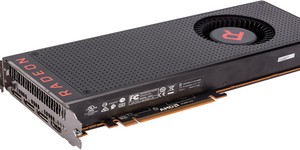
AMD has officially confirmed that its next-generation graphics processor microarchitecture, Vega, won't be coming to market until early next year.
Designed to offer roughly the same performance-per-watt improvement over Polaris than Polaris did over its predecessor, Vega is set to be built on the same 14nm three-dimensional FinFET process by AMD spin-off GlobalFoundries. Vega also promises to bring High Bandwidth Memory 2 (HBM2) to the table, offering an increase in the speed at which the GPU can communicate with the video memory. As with its predecessor HBM, HBM2 works by stacking memory dies vertically on an interposer board with a direct connection to the GPU to form a single-package GPU-and-memory combo with reduced latency and boosted bandwidth.
Originally, AMD had hinted at an October 2016 launch date for Vega, but it has now formally announced a different release schedule that sees Vega hitting retail in the first quarter of 2017. No reason for the apparent delay - which isn't, it must be noted, an official delay, as the October date was never officially announced - has been given.
Vega is scheduled to be replaced at the top end by Navi in 2018, which will include similar performance gains again along with increased scalability and what AMD teasingly refers to as 'Nexgen memory,' details of which have not yet been released. As with its previous launches, AMD is expected to release high-end enthusiast cards early followed by lower-cost mainstream parts later in the year. The company is also expected to be making much of the combination of Vega graphics cards with its upcoming Zen processor, and will likely launch upgrade bundle packages into the market in collaboration with its various hardware partners.
Designed to offer roughly the same performance-per-watt improvement over Polaris than Polaris did over its predecessor, Vega is set to be built on the same 14nm three-dimensional FinFET process by AMD spin-off GlobalFoundries. Vega also promises to bring High Bandwidth Memory 2 (HBM2) to the table, offering an increase in the speed at which the GPU can communicate with the video memory. As with its predecessor HBM, HBM2 works by stacking memory dies vertically on an interposer board with a direct connection to the GPU to form a single-package GPU-and-memory combo with reduced latency and boosted bandwidth.
Originally, AMD had hinted at an October 2016 launch date for Vega, but it has now formally announced a different release schedule that sees Vega hitting retail in the first quarter of 2017. No reason for the apparent delay - which isn't, it must be noted, an official delay, as the October date was never officially announced - has been given.
Vega is scheduled to be replaced at the top end by Navi in 2018, which will include similar performance gains again along with increased scalability and what AMD teasingly refers to as 'Nexgen memory,' details of which have not yet been released. As with its previous launches, AMD is expected to release high-end enthusiast cards early followed by lower-cost mainstream parts later in the year. The company is also expected to be making much of the combination of Vega graphics cards with its upcoming Zen processor, and will likely launch upgrade bundle packages into the market in collaboration with its various hardware partners.

MSI MPG Velox 100R Chassis Review
October 14 2021 | 15:04








Want to comment? Please log in.